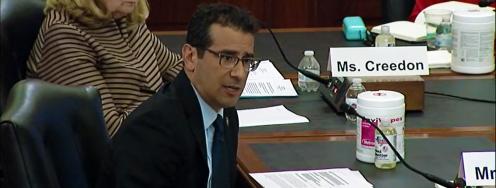Realistically Assessing Breakout and the Military Option
On the radar: Albright HASC testimony; New START one year later; Nuking the Metrodome; On tactical nukes in Korea; The good news on Iran talks; Frank Rose at ASP; Clean-up at Parchin; the Abbreviated life of NASA’s only reactor; and Nuclear experiments on humans.
June 21, 2012 | Edited by Benjamin Loehrke and Leah Fae Cochran
Better options on the table - “Increasing pressure with the aim of seeking negotiated concessions from Iran is the preferred route forward to prevent Iran from getting nuclear weapons,” said David Albright of ISIS in testimony before the HASC. “In the near term, military options should be avoided.”
--On an Iranian breakout capacity, Albright assesses that Iran would need “about a year” to build a crude nuclear explosive device and longer to build a warhead. However, Iran has not made the decision to do so and has not mastered the technology for weapons grade uranium. While Iran’s centrifuge developments are shortening breakout times, Albright notes “they remain long enough to allow for detection and prevention.” Full testimony here (pdf). http://1.usa.gov/PA6NdE
Improving national security - “One year of New START implementation has enhanced U.S. interests,” writes Terri Lodge of the American Security Project. “And it will continue to benefit U.S. national security as policymakers build on the treaty’s success to bring U.S. nuclear policy into the 21st century.”
--Among the benefits according to Lodge: the treaty improves U.S. force planning, enhances transparency of deployed systems and preserves modernization of the U.S. nuclear arsenal. The Hill has the full post. http://bit.ly/MgpEIb
Sole use - “I don’t think there are any good uses for nuclear weapons, but then, this may be one," said the late Kansas City pitcher Dan Quisenberry about the Minneapolis Metrodome. ESPN uses the quote to introduce its list of “Baseball’s 10 worst ballparks.” http://es.pn/LiTpwp
Welcome to Early Warning - Subscribe to our morning email or follow us on twitter.
--Have a tip? Email earlywarning@ploughshares.org. Want to support this work? Click here.
Tactical danger - Rep. Hank Johnson (D-GA) calls a provision included in the House NDAA considering re-deploying tactical nuclear weapons in South Korea a dangerous proposition in The Diplomat.
--”As we endeavor to reduce the role of nuclear weapons, and with tensions already rising in the Asia-Pacific, the proposal to redeploy American tactical nuclear weapons to Asian soil is ill-considered and reflects poorly upon this country’s Congress,” Rep. Johnson writes. Read the full story here: http://bit.ly/LBlT0R
Tweet - Mark @FitzpatrickIISS: I had hoped to visit NK this week, but Norks said timing wasn't good. How true, given my report for EU out on Monday: http://bit.ly/L7LGuA
Glass half-full - Barbara Slavin explains why the talks with Iran were useful, even if a diplomatic deal was not reached. “The Barack Obama administration has made enormous progress in consolidating an international coalition against the Iranian nuclear program. Holding these talks helps keep that coalition together.”
-- The good news: “Iran, unlike Pakistan, North Korea and Israel, has only slowly expanded its nuclear capabilities,” argues Slavin. Full-story at Al-Monitor.http://bit.ly/Lh6xSy
Event - “A Conversation with Deputy Assistant Secretary for Space and Defense Policy Frank Rose: On Missile Defense and European Security.” June 25 from 12:30-1:30pm at the American Security Project. Details and RSVP here. http://bit.ly/LEZYUV
Tweet - @Laicie Olson: On @TrumanProject's Doctrine Blog today: Persistence is Critical in Diplomatic Negotiations with #Iran. http://bit.ly/KWmZTG
New images - New imagery of Iran’s Parchin site suggest that activities there are an attempt to sanitize past nuclear weapons research, an allegation the IAEA wants to investigate with inspections of the site.
--”If Iran has nothing to hide, its activities at this site add a further layer of suspicion and negatively impact efforts to build confidence in the peaceful nature of Iran's nuclear program,” says the Institute for Science and International Security, the think-tank with the imagery. Reuters has the story. http://reut.rs/M4Xjpy
RIP: Plum Brook Reactor - In 1961, NASA turned on its Plum Brook nuclear research reactor in Ohio - a facility intended to help develop a nuclear-powered bomber or rocket. Both projects were canned before Nixon mothballed the facility in 1973. Decommissioning of the facility finished this year - costing $253 million or twice the price of building the facility. David Mosher at Danger Room has an article and photo set of the facility’s abbreviated life and slow, painful, contaminated death. http://bit.ly/L80k5j
Quote - “My hunch is that if there is no war between Iran and the West — which would probably strengthen the regime — hardliners will go the way of Mao, and Iran will end up looking something like Turkey,” writes Nick Kristof of The New York Times reflecting on his experience talking with young Iranians during his recent travels. http://nyti.ms/Nd2im0
Poorly titled secrets - In 1947, the Atomic Energy Commission began studying the effects of nuclear weapons by feeding irradiated food to handicapped children. The government didn’t want public outcry, so personnel engaged in a full cover-up. The details are explained in an memo conspicuously titled “MEDICAL EXPERIMENTS ON HUMANS.”
--The program continued for 15 years and was uncovered in 1987. Danger Room has the story in its compilation of poorly justified Washington secrets. http://bit.ly/MlyZkI



